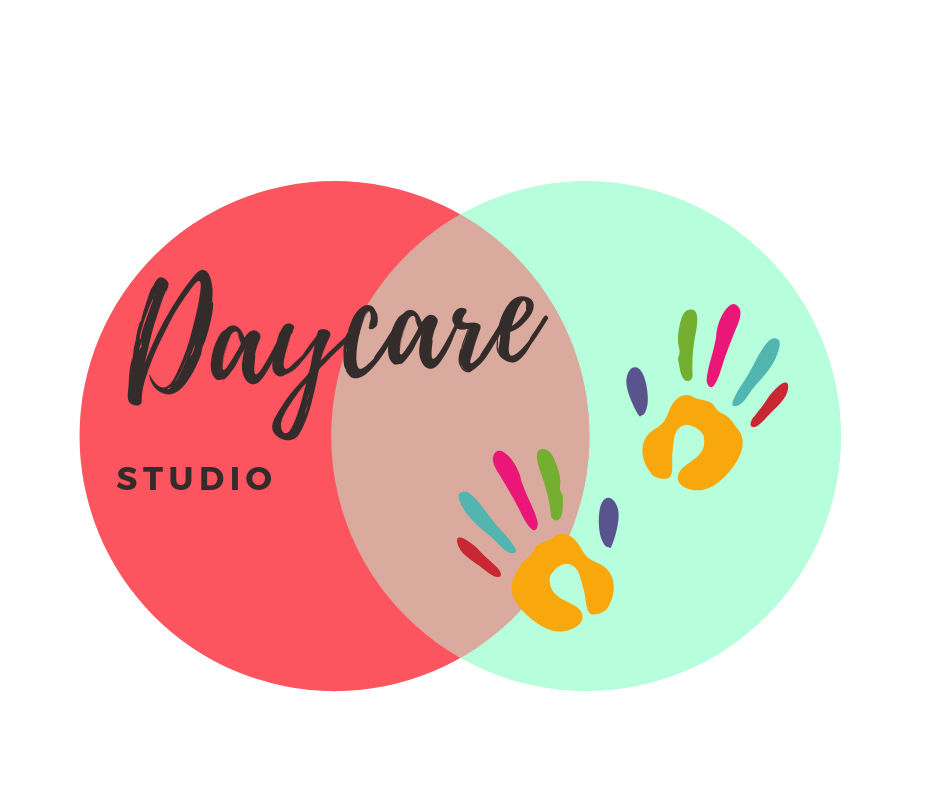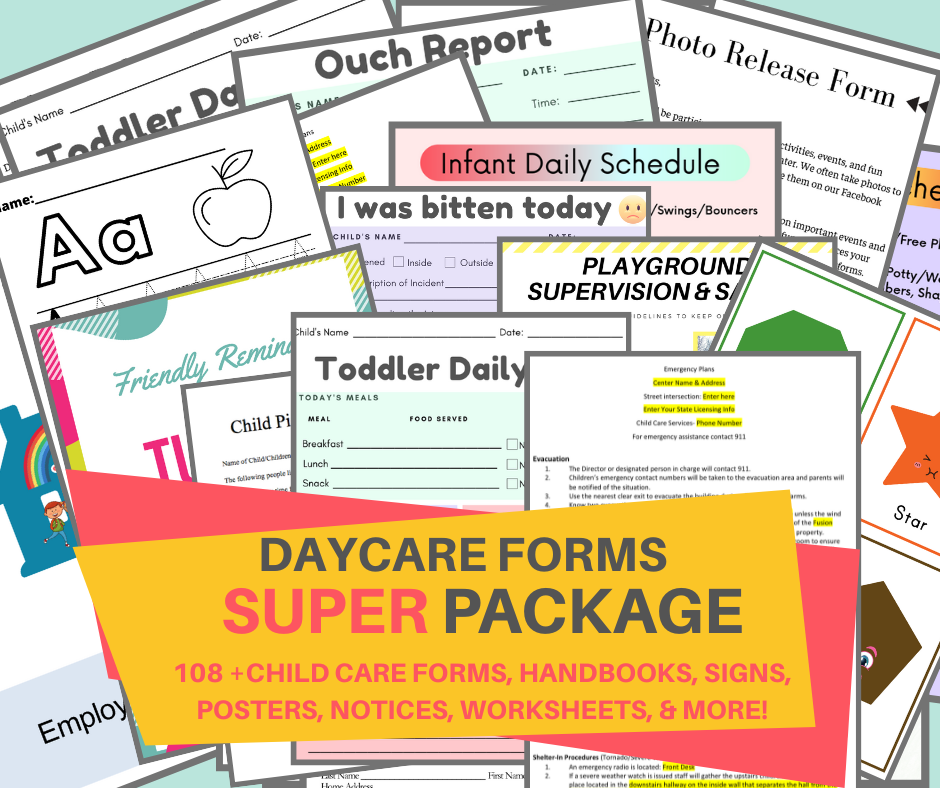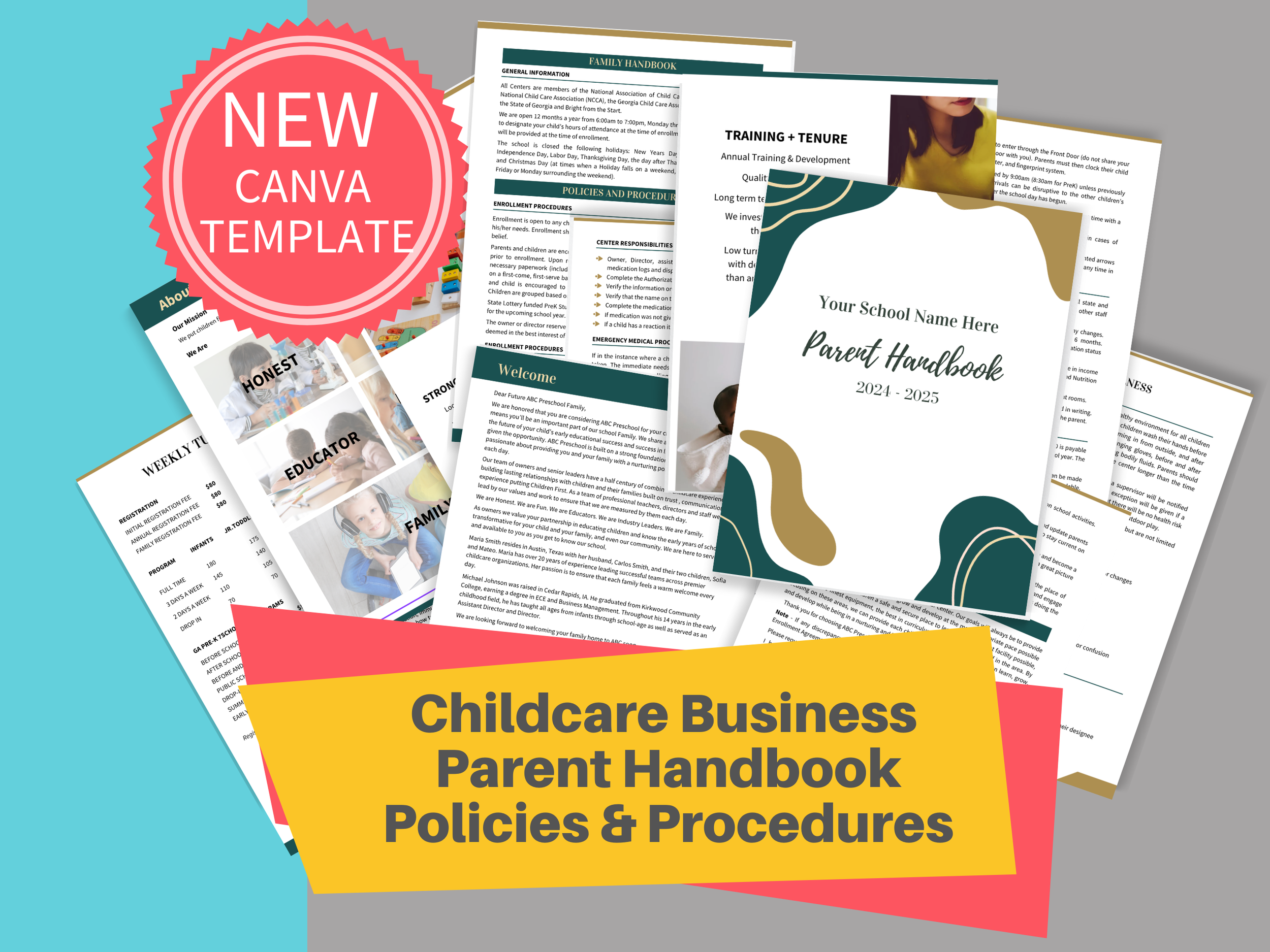7 Proven Strategies to Enforce Daycare Policies Without Damaging Parent Relationships
This post may contain affiliate links, which means I'll receive a commission if you purchase through my link, at no extra cost to you.Let’s be real—enforcing daycare policies isn’t always easy. You want to run a professional, organized childcare program, but at the same time, you hate confrontation and you don’t want to upset the parents who trust you with their children. Sound familiar?
Here’s the good news: you can enforce your policies and still keep those relationships strong. In fact, when done the right way, sticking to your policies can actually build trust and respect between you and your families.
Before we get started, If you're new to my site, remember to Grab my FREE Daycare Starter Guide to start your own childcare business. If you don’t know where to start, this 12 step guide to starting your own center or in-home daycare is perfect for you! Click here to get instant access and download. It’s super easy and absolutely free! 🙌
Let’s dive into 7 strategies that will help you enforce your daycare policies without damaging those important parent connections.
**Be sure and read to the end to download my FREE Policy Enforcement Email Templates.
1. Communicate Policies Clearly and Early
Let me ask you this—how can parents follow policies they don’t fully understand? They can’t! That’s why setting clear expectations from the very beginning is so important.
And here’s a big one: Don’t assume parents will read every word of your handbook. While providing a written handbook is essential, it’s just as important to go over the most critical policies verbally. Walking parents through these key points ensures they truly understand your expectations.
Here’s how to make it happen:
Parent Handbook: Hand out a detailed, easy-to-read handbook with all your policies clearly laid out.
Highlight Policies during Tours: During tours or enrollment meetings, go over key policies verbally. Here are a few important ones…
Operating hours
Drop-off and pick-up procedures (and what happens if they’re late!)
Authorized pick-ups (who can and can’t pick up their child)
Illness policies (when to stay home and for how long)
Tuition and late payment policies
Supplies parents need to provide (like extra clothes or nap-time items)
Allergy information and how it’s managed
Meal guidelines (times served, if outside food is allowed)
Outside play times (outside time is required)
Sign an Agreement Contract: Have parents sign an acknowledgment form saying they’ve read and agree to your policies.
Example Script:
“Before we finalize enrollment, let me walk you through some of our most important policies, like illness procedures, pick-up rules, and tuition deadlines. I’ll also send a handbook so you can reference everything later, but I want to make sure we’re on the same page about these key points.”
Taking the time to explain these policies upfront not only prevents confusion but also shows parents that you value clear and open communication.
2. Build Strong Parent Relationships from Day One
Here’s the thing—when parents feel connected to you, they’re more likely to respect your policies. So, focus on building trust and rapport with families right from the start.
Here’s how to do it:
Warm Greetings: Smile, look them in the eyes, and say hello during drop-off and pick-up. It’s a small gesture that makes a big impact.
Share Positives: Make a habit of sharing something positive about their child’s day, even if it’s just, “David was so proud of the tower he built during free play!”
Send Updates: Snap a quick photo or send a note about a fun moment—it makes parents feel involved and appreciated.
Take an Interest: Ask about their family, challenges, or exciting life events. This shows you care about them, not just their tuition check.
Example Script:
“Hi, I wanted to share how proud Ava was during circle time today. She volunteered to sing a song all by herself and did amazing!”
When parents feel seen and valued, they’ll naturally be more cooperative when it comes to following policies.
3. Explain the ‘Why’ Behind Policies
Parents are much more likely to follow your rules when they understand the reason behind them. Explaining the “why” builds trust and helps avoid unnecessary conflict.
How to do it:
Safety First: Highlight how your policies protect their child and others (e.g., illness rules).
Smooth Operations: Explain how deadlines or procedures keep the program running efficiently.
Real-Life Examples: Share stories of how your policies have helped avoid problems in the past.
Licensing Requirements: Point out when a rule is tied to state regulations or safety standards.
Focus on Their Child: Show how the policy benefits their child specifically.
Example Script:
“Our illness policy is there to prevent the spread of germs and keep all the kids safe. If a child comes in sick, it could mean others—and even our staff—might get sick, which disrupts care for everyone. I know you wouldn’t want another child attending sick and passing those germs to your little one, and that’s why we take this policy seriously. By working together, we can keep everyone as healthy as possible.”
When parents see the bigger picture, they’re more likely to cooperate.
4. Be Consistent with All Families
Consistency is key! If you bend the rules for one family, you open the door for others to expect the same. And trust me, that’s a slippery slope you don’t want to go down.
How to stay consistent:
Fair for All: Apply your policies equally to every family, every time.
Staff Training: Make sure your team understands your policies and enforces them the same way you do.
Document Exceptions: If you do make an exception, write it down and make it clear to the parents why it’s a one-time thing.
Follow Written Procedures: Have a step-by-step plan for handling policy violations so you’re never caught off guard.
Example Script:
“Hi parent’s name, I noticed you are arriving after our 9 a.m. drop-off time today. I completely understand that mornings can be hectic—it happens to all of us! Unfortunately, as outlined in our policy, we’re unable to allow children to attend for the day if they arrive after 9 a.m. This helps us maintain a smooth routine for all the children and ensures we can plan accurately for staffing and meal counts. I hope you understand.”
5. Address Policy Violations Promptly and Privately
When a policy is violated, it’s important to address the situation quickly and professionally. Ignoring it only makes enforcement harder down the line.
Here’s your game plan:
Act Quickly: Speak with parents as soon as an issue arises to prevent it from becoming a pattern.
Keep It Private: Have the conversation in a quiet, one-on-one setting to avoid embarrassing the parent.
Stick to the Facts: Focus on the policy and its importance rather than assigning blame.
Document Everything: Record the violation and any actions taken in case it recurs.
Use Gentle Reminders: Depending on the violation, you can offer a friendly warning the first time and use it as an opportunity to kindly remind parents of the policy. This approach helps reinforce expectations without creating unnecessary tension.
Example Script (First-Time Late Pick-Up):
“Hi [Parent’s Name], I noticed you arrived after our pick-up time today. I completely understand that things come up—it happens to all of us! Just as a reminder, our policy is to have all children picked up by [specific time], and late pick-ups usually result in a fee. Since this is the first time, I won’t charge the late fee, but I wanted to make sure we’re on the same page moving forward. Let me know if you have any questions about our policy—I’m happy to help!”
Prompt, professional conversations help maintain respect and prevent repeat issues.
6. Lead with Empathy
Sometimes, enforcing policies takes a little compassion. Parents are juggling a lot, and showing you understand their challenges can make all the difference.
How to lead with empathy:
Acknowledge Their Feelings: Let parents know you get where they’re coming from.
Listen First: Give them space to share their frustrations or struggles. Sometimes, they just need to be heard.
Find Common Ground: Remind them you both want the best for their child.
Offer Support: Suggest practical solutions to help them comply with your policies.
Be Patient: Sometimes parents need time to adjust—show them you’re willing to work with them.
Example Script:
“I wanted to check in with you about your tuition payment, which was due on [specific date]. I completely understand that unexpected expenses can pop up—it happens to all of us! However, timely payments are important in keeping our program running smoothly. Is everything okay, or is there something I can help with?"
"Thank you for sharing that. I understand things can get overwhelming sometimes. Let’s talk about a plan that works for you, and I’ll make a note in our system so everything is clear. Thank you for keeping me in the loop—I’m always here to help however I can!"
Empathy goes a long way in keeping the conversation positive and productive.
7. Be Ready to Enforce Consequences
Even with the best intentions, some parents will still push boundaries. That’s when you need to fall back on clear consequences to protect your program.
How to enforce consequences:
Document Violations: Keep a written record of repeated issues.
Issue Warnings: Provide verbal or written warnings if necessary.
Follow Through: Stick to your policies and don’t backtrack on consequences.
Have a Termination Plan: Be prepared to end care if a parent consistently violates your policies.
Example Script:
“As outlined in our handbook, repeated late tuition payments result in a late fee. If the issue continues, we’ll need to reevaluate the enrollment agreement. I truly value having your family with us and want to continue caring for [Child’s Name], so let’s work together to find a solution and avoid that outcome.”
While enforcing consequences isn’t fun, it’s necessary to maintain fairness and professionalism.
Final Thoughts
Friend, enforcing daycare policies doesn’t mean being the bad guy. It’s about creating a safe, professional environment where kids can thrive and parents feel supported. By combining clear communication, strong relationships, and a touch of empathy, you can confidently enforce your policies while keeping parents happy and respectful. You’ve got this!
Need help writing your policies? Check out my done-for-you Parent Handbook Template Here—it’s the perfect tool for creating clarity and consistency in your program!
And don’t forget to click here to download my FREE Policy Enforcement Email Templates —a ready-to-use collection of 10 professionally crafted emails designed to help you address common policy issues like late payments, drop-off times, and more with confidence and professionalism. They’ll save you time and take the stress out of those tough conversations!
Here are some other articles packed with valuable content you are sure to enjoy:
10 Ways To Increase Revenue In Your Daycare Business
6 Must-Do’s To Effectively Communicate To Staff
How To Avoid Burnout in Childcare
How To Screen Families For Your Daycare
6 Tips To Ace Your Licensing Inspections
30 Daycare Policies You Need in Your Parent Handbook
Important Daycare Forms You Need For Your Childcare Business
How To Deal With Parents Who Consistently Pay Tuition Late!
Download my FREE Family Screening Guide to select the families right for you.
Download this guide to help you carefully accept the right families and avoid the high-maintenance ones. Includes 13 questions and a Family Information Card for easy follow-up.
Grab my FREE Daily Schedules for Infants, Toddlers, & Preschoolers!
Download 3 PDF schedules designed for each age; Infants, Toddler, and Preschoolers. A Canva link is provided to edit the schedules for your program. It’s absolutely free and only takes 5 seconds!
Download my FREE Daycare Starter Guide to start your own childcare business.
If you don’t know where to start, this guide is perfect for you! Click the button to get instant access. It’s super easy and absolutely free!


















